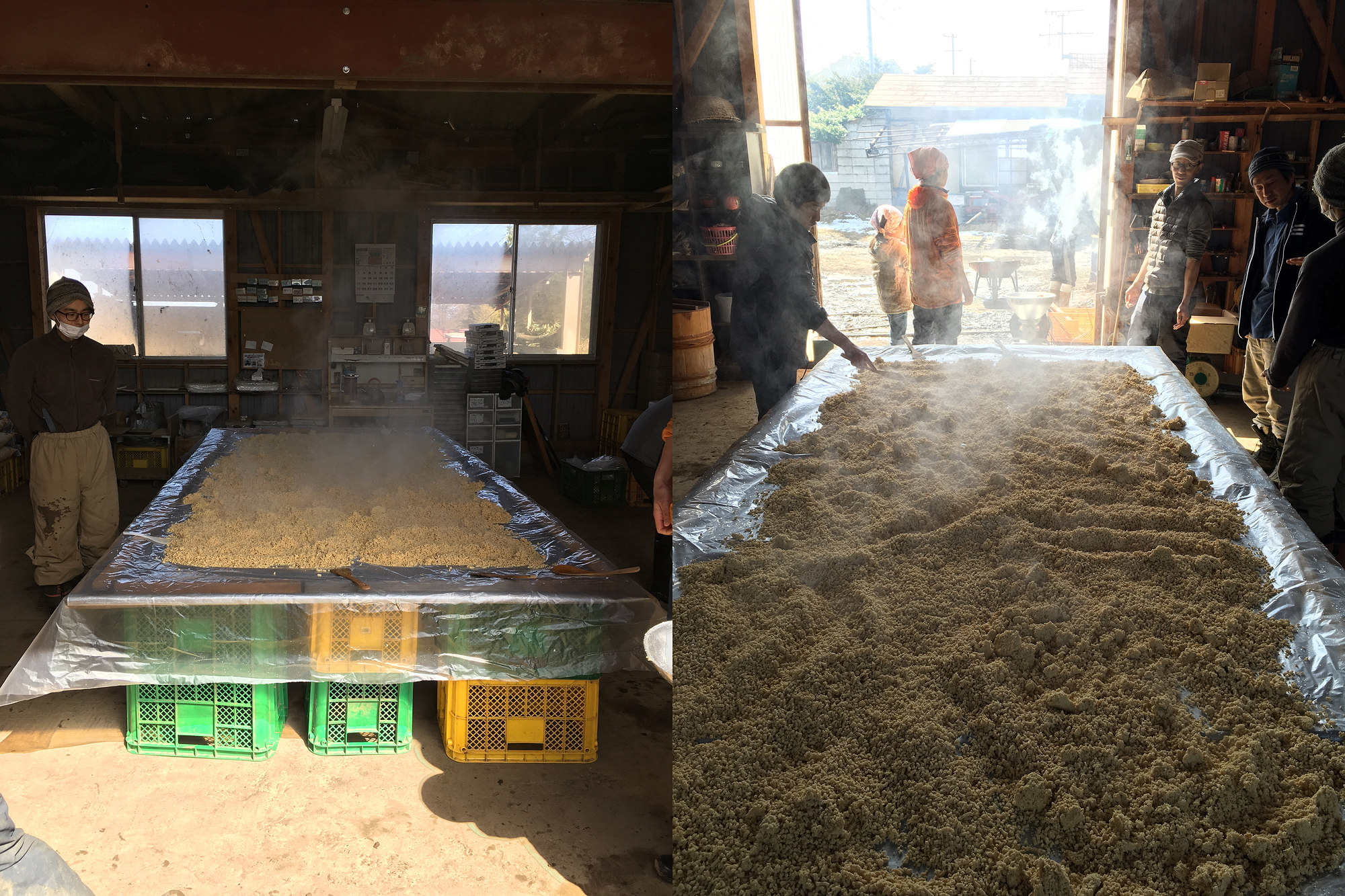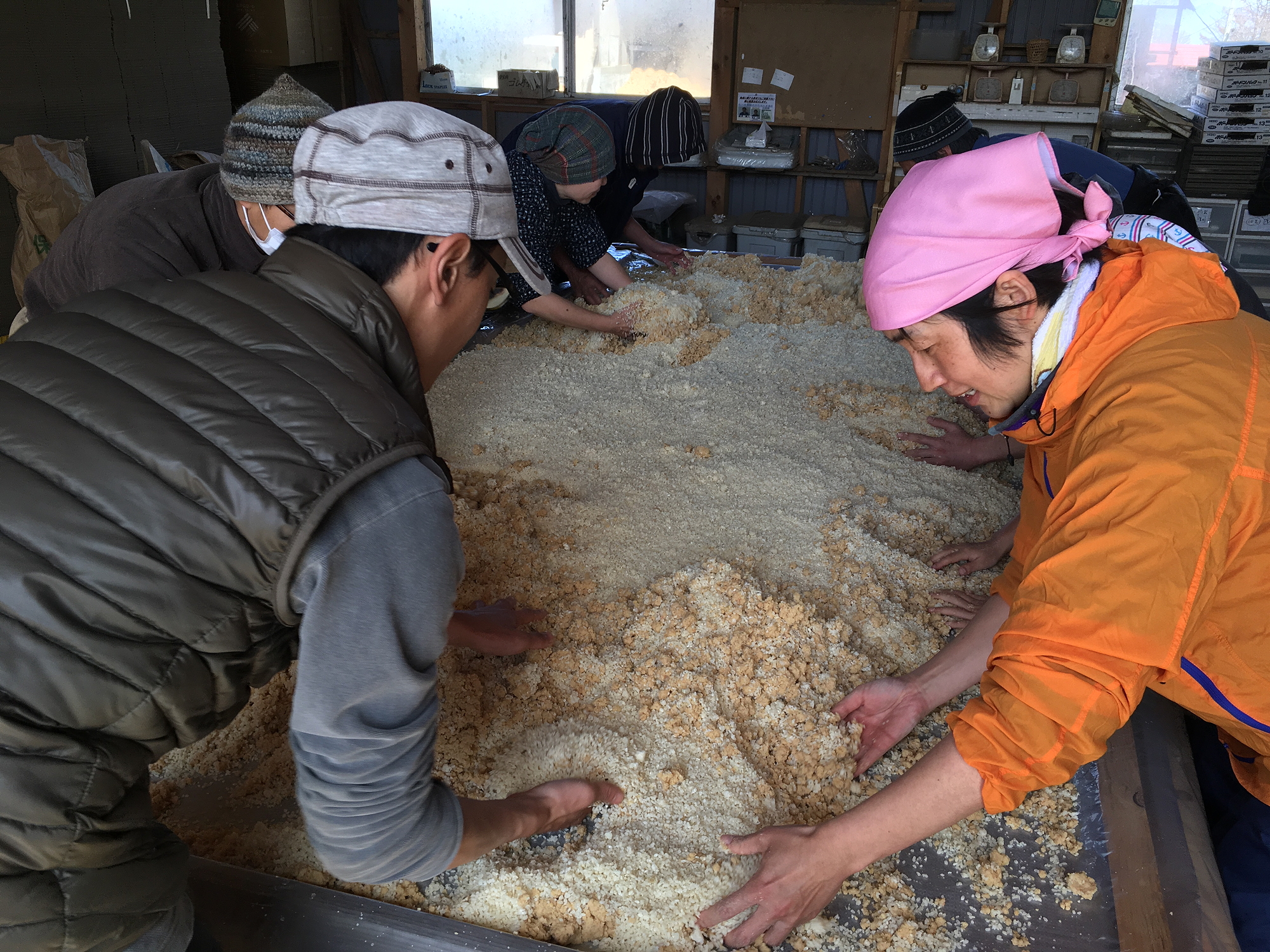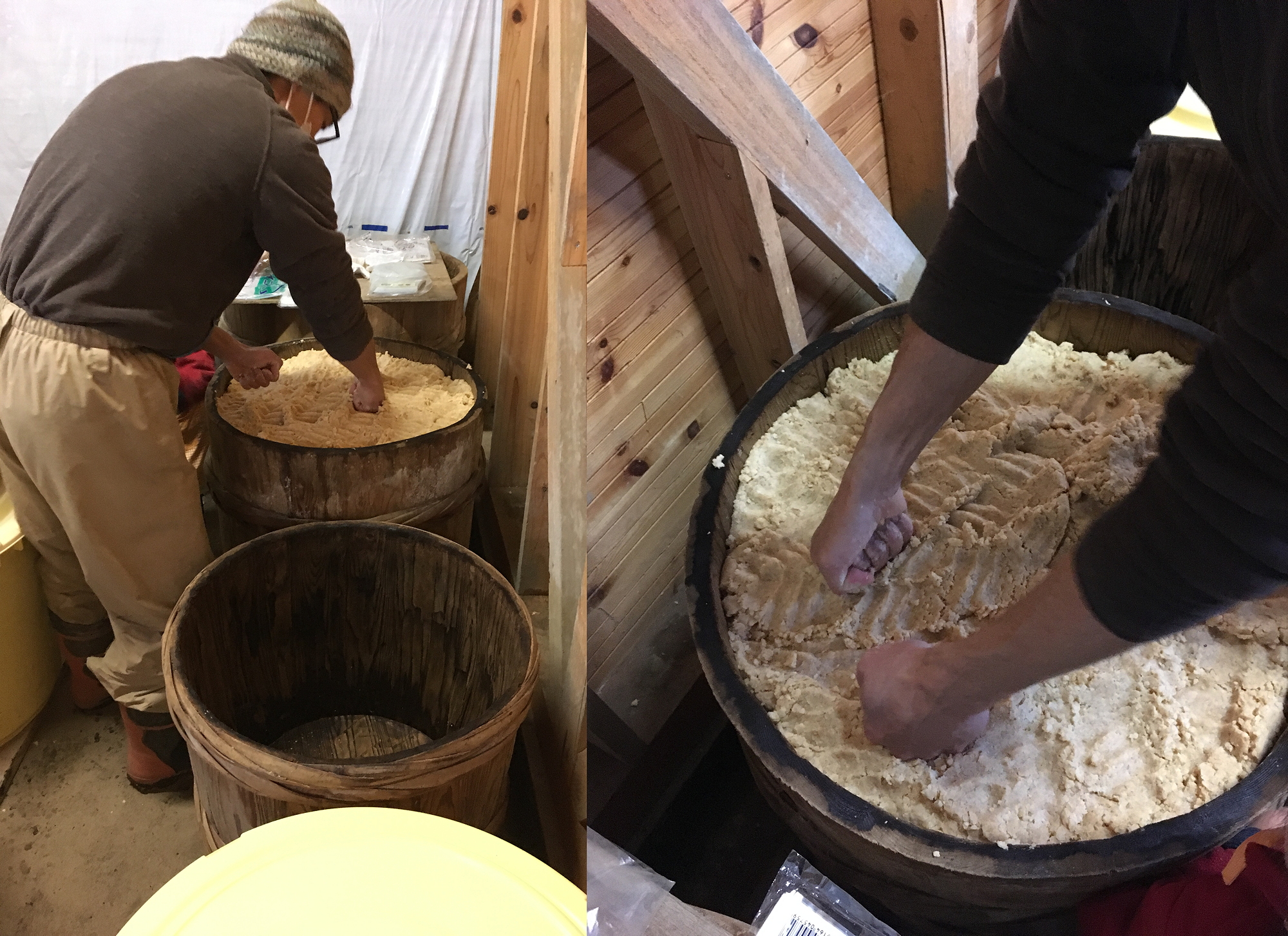Farming in Japan: Making Miso
While not technically part of farming itself, making miso みそ/味噌 is closely connected to farming and traditional lifestyle in the countryside of Japan: not only do many small-scale farmers still make (and often sell, too) their own miso, some people in the city do, too. Although I have actually made some myself (last year, from a kit I bought from Daichi wo Mamoru Kai 大地を守る会, a well-known organic vegetable delivery company), this was the first time I got to participate in a full-blown traditional miso-making farming event so I was glad to be able to attend (I had actually been invited the year before but was unable to attend because I was in Ibaraki 茨城県 Prefecture helping my father-in-law prepare his rice seedlings for the year's harvest).
Nagano and miso
Whilst miso is of course made all over Japan and is consumed all over the world, I guess I can consider myself privileged to have helped made some in Nagano 長野県: as a fermented food, extremely healthy, easy to make and easy to preserve, miso is somewhat characteristic of Nagano, the prefecture with the longest average life expectancy, in Japan and therefore the world. Indeed, Nagano miso - or shinshu miso 信州味噌 as it is officially called - routinely takes up the most space of any product in Nagano supermarkets and is highly sought after in other prefectures, too. Style-wise, it is quite particular, too: whilst miso from Kyoto 京都 is often quite sweet, light in colour and made with a high percentage of rice, and miso from Nagoya 名古屋 is famously made with very little if indeed any rice, and is almost black in colour, miso from Nagano tends to be quite rustic, a little rough, quite salty and contains both daizu 大豆 (soy beans) and kome 米 (rice).
Making miso the Yui Shizen Nōen way
Like most miso producers, Yui Shizen Nōen ゆい自然農園 - the farm I did my apprenticeship on last year (read more about that here and here) - have their own way of making miso, not just because their recipe is slightly different to everyone else's, or because they grow the main ingredient (soy beans) themselves, but mainly because the strain of bacteria that start the fermentation is peculiar to their cellars, in just the same way as in a Japanese sake 酒 brewery or a Belgian lambic beer brewery. Also, unlike the kind of miso made industrially and sold in most supermarkets, the Yui family miso is allowed to live on past the end of the basic fermentation, being neither pasteurised or sealed off from air: this means that there is no need to store it in a fridge and that it will continue to age (and oxidise, if you let it come into direct contact with the air).
1. Cooking and milling the soy beans
Much the same as with sake, in order for the rice kōji 麹 (an enzyme whose job it is to convert the starches into sugar) to be effective, the soy beans have first to be cooked. This is done in special cauldrons, kept boiling over wood fires. Because the beans will continue to cook even after they are removed, and because they need to remain a little hard in order to prevent the koji converting all the starch to sugar, the beans are checked upon regularly and ladled out into sieves before they get too soft.


Once any excess water has run off the beans are run through a mill to turn them into a paste, increasing the surface area and making it both easier for the koji to work on, and quicker for the paste to cool down to the appropriate temperature.

2. Spreading out the soy beans
Once milled, the soy-bean paste is spread out onto a large table (large enough for both the quantity of bean paste, and the number of people working it) for it to cool down a little (a first it is too hot to handle) and to be mixed in with the other ingredients.

3. Mixing the other ingredients into the soy paste
Along with soy beans, the other ingredients in typical Shinshu miso are salt and rice (or, rather, salt and rice koji: rice impregnated with koji - otherwise known as aspergillus oryzae, a probiotic enzyme). These are mixed in with the soy bean paste once it has cooled sufficiently to be worked by hand (not just because it is easier to handle, but because any hotter and it would kill the enyzymes), on a large flat table, much as in a sake brewery.

Salt is mixed in first, probably because it can stand the heat better, because it naturally protects from infection, and because it helps break up the soy beans which otherwise have a tendency to stick together as a paste a little too much. This part can be quite painful on the hands: not only is the mixture hot, but the salt tends to find its way into any cuts on the hands, however small..!

Rice koji - komekoji in Japanese - is then mixed in and the kneading continues, gaining momentum: first the mix is pushed into the centre, then pulled out to the sides, then back into the centre, making the mix as homogenous as possible.
4. Kneading, pounding and packing the mix

Once the ingredients are all mixed together satisfactorily, the paste is kneaded and squeezed into balls and cones to exclude any air and to make carrying them into the inner cellar easier. As the first part of the process nears its end, the paste - in balls and cones - is literally thrown into the large barrels in which it will age: the idea being yet again to exclude any air. It is then punched down and covered with a layer of salt, again to protect from both the air and foreign microbes.

The mix is then left to ferment and mature, usually for a minimum of six months (although when I worked there last year, the farm had a good stock of three year old miso). Because it is still technically alive and quite capable of defending itself, it does not need to be kept in a fridge and can be transported in a simple plastic bag or other container which protects it from contact from the air (not that very much happens if it does come into contact: it just gets a little crusty, but can still be used).

Miso in cuisine
As for uses, well there are so many, it is hard to know where to start! Obviously, miso-shiru 味噌汁 soup is the most common use, but miso-tsuke 味噌付け pickles are also a traditional staple. It is also used in sauces and dressings: for an alternative to a regular French-style vinaigrette, try miso, mixed with ponzu, and for a dip try mixing some with some mayonnaise. Some kinds are also good in pastry and European cuisine: the Nagoya style black miso is sometimes used by chefs in black chocolate cakes and puddings, whilst Nagano and Kyoto styles can both be used to baste meat. But if you want something really simple, try just dipping a carrot or a stick of celery in a some miso and eating it as is!
When he's not obsessing over heritage varieties of vegetables & herbs, chasing off wild deer or otherwise running around the fields of his mountain farm, he's trying to beat the system, taking photos or trying to better understand cryptocurrencies.
You can find his Steemit introduction here
You can find out more about his farm here: @potager-cerfs
So that's how miso is made! Definitely a labor of food, but so worth it! Thanks for the post. Very informative.
Thanks for the comment! Making miso is really no more difficult than making bread. Once you have the ingredients, and have cleaned all the utensils, pots and pans, it's pretty quick and simple. And, as I said, it's even easier to look after and use than most foods, and will last as long as you want it to.
This is awesome man!
Cheers man! What I lack in quantity, gotta make up for in quality, I guess ;)
Man. You write some of the most high quality content I have seen. And your photography and all the background information provided is phenomenal.
By the way, VJ LIVE! is back. You wanna come on again sometime?
I just did the return episode tonight here on Steem/DLive if you're interested.
Cheers man, you've always been a great support! Sure would! Been having a hard time recently keeping track of your posts (just came across your video on sowing seeds on Youtube but couldn't find it here on Steemit...) but I did gather that VJ Live was back so I'd be more than happy to be on again!
Thanks for the write up on this, I enjoy reading about local processes of farmed food.
Thanks man! Glad you enjoyed it!
Je n'ai pas tout compris car mon niveau en anglais laisse vraiment à désirer, mais rien que le mot 'miso' et de se dire qu'il est fait maison, me fait frissonner :)
C'est tellement enrichissant de faire les choses par soi-même!
En fait, c'est assez facile : ici, ils en ont fait à peu près 700 kg sur deux jours alors ça demande un peu de monde et de préparation, mais s'en faire 5 ou 10 kg à la maison, c'est assez simple et assez rapide. Finalement, ce qui prend le plus de temps, c'est bien nettoyer les ustensiles et faire cuire les fèves de soja. Oh, et attendre 6 mois pour le manger, bien entendu !
5 à 10kg c'est déja une bonne quantité rien que pour soi :)
Attendre 6 mois, c'est une histoire de fermentation?
Au fait, quand tu es parti au Japon pour créer ta ferme tu avais un bon bagage niveau budget pour t'installer là-bas?
Et est-ce que tu parles japonais?
C'est clair ! 5-10 kg ça suffit pour une année. Surtout qu'ici, du miso j'en reçois à droite et à gauche ! A la maison, du miso et du riz (le père de ma femme est agriculteur de riz, mon voisin à la campagne aussi), on en a à ne plus savoir quoi en faire !
6 mois, c'est pas nécessaire, 3 mois devrait suffire, mais la texture et le goût s'améliore avec le temps. Après, c'est comme le vin, le fromage etc. : certains préfèrent jeune, d'autres vieux.
Quand je suis parti au Japon, la société de ma femme nous a payer les frais de déménagement. Du coup, on en a profité pour emporter pas mal de choses pas forcément "nécessaires" (du vin, des outils agricoles, un tas de livres etc.). Pour ceux qui n'ont pas cette chance, louer un container c'est assez abordable.
Oui, j'ai étudié le japonais en fac (license et maitrise), du coup je me débrouille pas trop mal.
Hello @nicksikorski , I was designed to give advice to "steemit" users.
I recommend to increase this;
The most winning bid bot in the last 24 hours is ✅ "smartsteem"
You can enter "steembottracker.com" to find more offers.
You can make "Resteem" and advertise to the followers of the whale accounts.
"Resteem Bot" for you;
✅ @byresteem has 25.500 Followers + 7000 Sp + Upvote with min +55 accounts.
I am a bot, I can not answer the comment. I hope I could help. Good luck.